The Girl Who Went to the Moon
A Visit to Japan Illuminates Her World
Article and photos by Brooke
Griffin
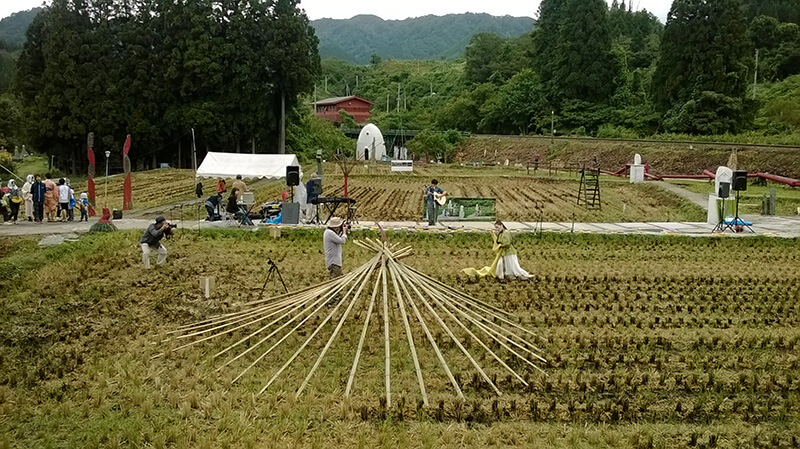
|
|
A dancer performs in a rice field during a
festival near the author's new home in Toyomi, Japan.
|
The bullet train out of Tokyo is packed with pressed white shirts, black suits, and briefcases. When I disembark at the city of Koriyama, it takes a while to find the local train that will deliver me to my next destination. When I finally find my platform, I feel like I’m boarding the train in Spirited Away, which is rickety, old, and filled with an eclectic variety of people. Once the train sets off, terraced hills of farmland roll past us at a modest pace, revealing rice paddy after rice paddy. Upon finally reaching Aizuwakamatsu, I hop off. I am greeted by a local high school marching band performing in front of the station. They’re not performing for me, but they might as well be. In addition, Kentaro, the host, will greet me there and determine the course of my life for the next four weeks.
Kentaro is old and young. Despite being in his 60s, he is one of those people you can immediately picture at seven years old because he still has that unselfconscious grin of a child. He shakes my hand vigorously while I laugh and bow clumsily. His English is a mess, but I love it because my Japanese is a mess, so we speak a funny pidgin of the two. It’s a hot September day, and he throws open the trunk of his minivan so I can toss my backpack. That’s when I see somebody in the backseat. “My mother wants to meet you, she is 91 years old,” Kentaro explains as an elderly woman attempts to turn her head to look at me. I walk around to the passenger seat to smile at her and see that she is beautiful. She falls asleep immediately as we start the drive home, a destination that turns out to be almost 90 minutes away.
For the first half of the car ride, Kentaro uses his limited English to try to tell me how wonderful I am. “Everybody else says they will come, but nobody comes, and now you are here! You are wonderful! I am waiting two years and nobody comes! Wonderful!” I laugh some more and try to ask my questions while answering his, but I get the sense that I won’t know where I’m going until I’m there. The highway out of Aizuwakamatsu is surrounded by sprawling farmland beneath lovely mountains. However, it still bears many marks of a city — an example of Japan’s “rural-urban fringe” that I read about before coming here. Kentaro pops in a mix CD that somebody made for him, filled with an equal number of bad pop songs in English and bad pop songs in Japanese. When a 1980s American love ballad comes on, Kentaro eagerly asks, “I don’t understand this song. What is she saying?” I listen to the song's words and remember a word we learned in class, shitsurenshimasu, which means “to be disappointed in love.” The Japanese have a word for everything. I explained, “Kanojo wa shitsurenshita,” which means “She was disappointed in love.” Kentaro laughed as I realized he probably already had that much figured out.
As we drive further and further, the signs of city life trickle away until we’re alone on the road. And while I know the lovely mountains are still there, I am too distracted by the interfering scenery of towering dark green trees and a crystal blue river that peeks out here and there off to the right side of the highway. Anticipation is starting to build in me that I haven’t felt before on my travels, a realization that I’m in for something… different.
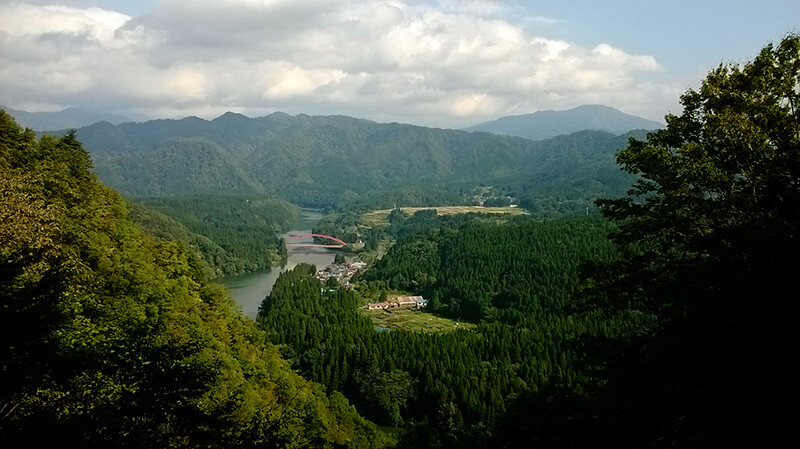
|
|
Above the river and valley of Toyomi.
|
I originally became interested in Kentaro because he’s a sculptor living in a rural area of Japan. I’m eager to learn about the arts' role in agricultural communities. However, honestly, going in, that’s about all I knew.
I have a short list of rules that function as a personal code for my travels. Topping my list is Ichiban (#1) Rule, the most important advice I can give anyone diving into authentic culture-oriented travel: no expectations. Along with this rule, I try to do as little research as possible about where I’m going, instead focusing on finding people who seem kind and enthusiastic about cultural exchange. When I told Japanese friends that I was headed out to the rural prefecture of Niigata, most responded that they had never been there and had no intention of going. The prefecture is famous for its high-quality rice and high-quantity snow, but that’s all that anybody I met knew about my destination.
Because of all this, I was not prepared for Toyomi. When we finally break free from the thick forest of trees, I can see that we’re following the river, weaving between gorgeous mountains. Everything seems increasingly poetic as we putter along, the only car in this mysterious valley. On a road that appears to be carved out of the mountainside, we pass through twelve wonderful tunnels, each named for one of the twelve months. After the tunnels, we cross a series of long lean bridges, each painted in a different color. Toyomi’s color is red, which I find out as we cross this marvelous structure that I will wake up to every morning for the next four weeks.

|
|
The red bridge crossing the river to Toyomi.
|
We’re here. It’s a tiny street of tiny old Japanese houses. That’s it, that’s Toyomi. One home is unlike any others; it is painted with garish turquoise paint dripping all over the driveway and scaffolding surrounding the front door. We pull into this driveway as Kentaro asks, “Do you like it?” pointing at the façade. I laugh and nod because I don’t know what else to do. As you might have noticed, this kind of interaction happens quite often. Kentaro runs into the big blue house to get a wheelchair for his mother, and I help her out of the van, for which she is infinitely grateful. I am, in turn, thankful for her gratitude, and we giggle like schoolgirls as I bow to her. She smiles up from her wheelchair.
Instead of heading into the big blue house as I expected, we wheel Obaachan (“Grandma”) next door into an old traditional wood house. “This is my wife’s restaurant,” Kentaro explains as we slide the doors open, and several people rush out to greet us. I meet my new mother, whom everybody in the restaurant calls Okaasan (“mother”). She says in English, “Hello Brooke!” which is the most beautiful thing to hear in a foreign country. I am offered a seat and an afternoon snack that is just an ear of corn. The food offering seemed humorous until I bit into it and understood why they wanted this to be the first thing I tasted in their home. Sweet, simple, delicious.
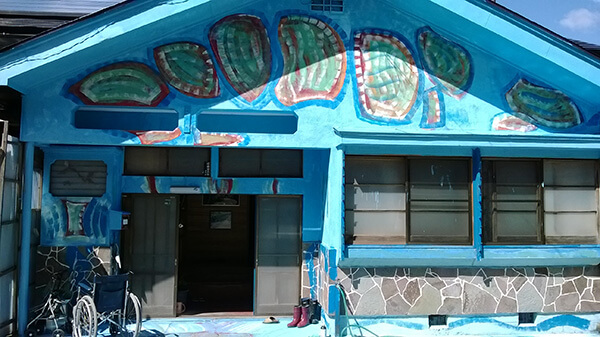
|
|
The blue house.
|
I delightfully close my eyes and grin sheepishly as the juice drips down my chin, and everyone laughs. Looking around, I glimpse the faces of my new friends and answer questions in that lovely English-Japanese pidgin language. Here, it’s more fun because everyone around the table will argue over the English translation of what they’re trying to say until they finally agree on something that makes no sense to me. Similarly, half of what I say in Japanese is met by blank stares — or, more accurately, blank smiles. And I realize amidst this wonderful chaos that this is simultaneously the most welcomed I have ever felt anywhere and the furthest out of my element I have ever been.
I listened to Kentaro and the others discuss their plans to keep me busy in the coming weeks, and I’m pleasantly surprised to hear that Kentaro is planning a big art show that will take place during my stay. Beyond that, I understand very little, but it doesn’t matter because Kentaro jumps up and signs for me to follow with my backpack. You have to realize that Kentaro never walks; he is always scuttling — sometimes on the point of running — to his destination. His movements are sharp, quick, and directed, and I’m constantly stumbling behind, trying to catch my breath. He grabs some keys from inside the blue house, and we scuttle/stumble along the one tiny street. After a few blocks, we turn and end up at a small, traditional-looking house, unlock the door, and are suddenly surrounded by stone figures. Foxes, squirrels, owls, monkeys, and all the creatures of the forest look up at me in perfectly chiseled silence. “This is my art museum. You sleep here,” Kentaro says to me, grinning, as he slides open a door to reveal a small bedroom.
I can’t contain myself this time, exclaiming, “Ehhh? Sugoi! Subarashii!” which roughly translates to, “No way, this is amazing! It’s wonderful!” He is pleased with my reaction, but before I can settle in with my new little friends, he gives me the same sign as before to come to the next stop on our journey. We run back to his house, jump into a truck large enough to carry horses, and drive back towards the red bridge, stopping at rice fields before the river. I hadn’t realized when we drove into the village that these were Kentaro’s fields, but now it makes sense, as I know they are filled with strange sculptures. There are games you can play with friends, a small playground, and many sculptures intended for looking at, not interacting with. And yes, these are all in the rice fields. I stand there amazed, but as usual, I don’t have time to be amazed because Kentaro is already off to work.
On my first day in Toyomi, we set half of the rice fields on fire. I’m not joking. Kentaro hands me a box of matches, shows me what to do, and says, “Fun!” with his seven-year-old smile. I set fire to the parts of the field where the rice had already been harvested, and he was right in predicting that I would enjoy watching the flames slowly lick their way down each row. Kentaro thinks of something else and runs off, and then, before I know it, I see him running back again. He has his camera and tripod and takes self-timed photos of us working together. I am always giggling uncontrollably in these photos at how ridiculous I feel. We spend my first afternoon in this way. By dinnertime, I’m hungry for an actual meal, exhausted by Kentaro’s excessive store of energy and reeking of smoke.
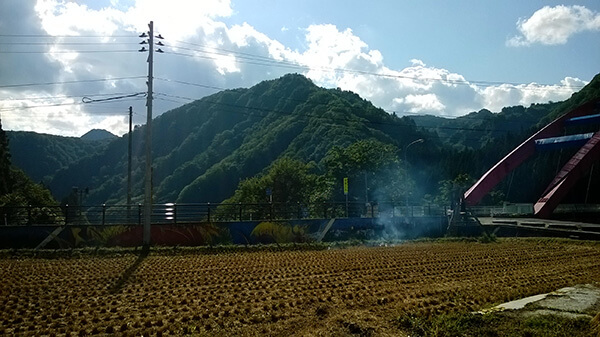
|
|
The harvested parts of a rice field the author was asked by her host to set on fire.
|
As we drive back to the house, I notice that the sun has already made most of its journey across the sky and casts a beautiful light over the single-street village. When we arrive home and run to the restaurant next door, the table is set for us and the restaurant employees. Kentaro shows me the beautiful spread of food and explains, “We are vegetarian, four years ago I got cancer, and we stopped eating meat. All of this is very, very healthy! And my wife is a very good cook!” I nod obediently, wondering if I’ll fill up with rice and vegetables. Once we eat, I fill my plate with vegetarian dishes and say “Itadakimasu,” which means “Thank you for the meal.” Okaasan glances over at me and raises her eyebrows suggestively. “You drink… beer?” she asks. I laugh and decline the offer, but she mistakes the laugh for a “Yes,” and before I know it, we’re clinking our glasses and saying, “Kanpai!” which is Japan’s “Cheers!” Kentaro doesn’t drink, and he explains that since his cancer diagnosis, he has given up all alcohol.
The vegetable dishes are incredible. This experience turned me into a vegetarian. I haven’t eaten meat since. There’s fish, too, which I realize is still considered “vegetarian” by this family. As I was warned, black rice is the best rice I have ever had (and probably will ever have). I eat until I’m stuffed while everyone compliments my chopstick handling. Afterward, we all sit and talk at the table for almost two hours. Among friends, the time flies. I feel like I’ve found home somehow. This place is more than home could be. I say “Gochisosamadeshita,” which means, “I’ve had plenty.” By the time I’m off to bed, I’ve had three glasses of beer (far beyond my usual limit) and have to find my way back to the art museum in the dark. No, I’m not drunk, just a little, well, off balance. And I can’t remember where to turn to get to the museum.
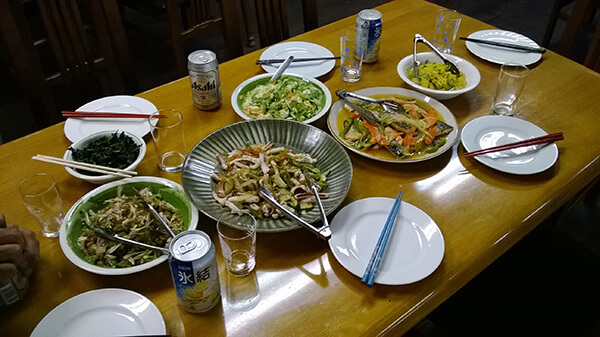
|
|
Vegetarian meal and beer at the restaurant next door.
|
As I traverse each block, since I know I will eventually find the museum in this tiny town, I casually look up and stop. Above me are thousands upon thousands of stars, as if God spilled his salt right here over Toyomi, and the rest of the world is just seeing the few grains scattered in other directions. I crane my neck and spin in circles until I’m dizzy and can see galaxies. I’m on the verge of tears as my body is filled with that wonderful sense of my smallness. Being small doesn’t necessarily mean being unimportant. After all, look at Toyomi. It's small but perfect. Or perhaps better said: Small is perfect.
When I finally arrived at the art museum, it’d probably been almost 45 minutes since I left the restaurant. Unlocking the door, I find my bedroom, which I now realize is just an empty square room with tatami mat floors. I open the closet and pull out my futon, which is not the same as a Western futon but rather a sort of mattress that you can roll onto the floor. The Japanese have slept this way for thousands of years. I feel like I have some deep connection to history as I snuggle under several blankets on this cool summer night. As I set my alarm for early the following day, I noticed it was not even nine o’clock. But I’m too tired to care and pass out immediately in my buzzed joy from the long day.
At 6:45, my alarm starts beeping. I turn it off drowsily, rolling around in more blankets on this surprisingly cold morning. But I know breakfast is at seven, so I suck it up and layer on some fresh clothes, grabbing my hat and the towel I hung around my neck the previous day. Walking back to the house, I gaze at the red bridge, and the green mountains shrouded in clouds. I arrive at the house around 7:05 and bow to Obaachan, who sits in a recliner in front of the entryway. “Ohayougozaimasu!” she says, and I repeat it, meaning “Good morning!” “Did you sleep okay? And wake up okay?” Okaasan asks, and I affirm that I am, indeed, okay. But Kentaro was nowhere to be seen, and I figured out from Okaasan’s explanation in Japanese that he had gone to look for me because I was 5 minutes late. I remind myself never to show up late again, noting that this was a rookie’s mistake. We didn’t even learn the word “late” in Japanese class because our teacher said we should never have to use it.
Kentaro soon rushes in, overjoyed to see that I did indeed find my way back. But his home is pretty hard to miss, after all. We seat ourselves and say, “Itadakimasu.” I look down at my plate to see little fishies about six inches long, fully formed, and with eyes looking back up at me. I watch Okaasan delicately pick up her fish with her chopsticks and nonchalantly bite the head off. Returning to my plate, I know I am incapable of such a feat. I tear the fish in half with my chopsticks and start from the middle, and I am surprised by how good it is. I slurp at my miso and pick at the rice in my bowl, but Kentaro stops me. “No, like this,” he says, showing me how to hold the rice and soup bowls as I eat from them. Indeed, I notice that everyone else at the table is taking this form, so I observe and mimic to their delight (and my own).
After this meal, I become more attentive to my eating style. I fill my diary with lengthy descriptions of Okaasan’s manner of eating; it is artful. There is patience to it and a sort of contemplation of the food. You admire your meal before consuming it and even more so while chewing it. It reminds me of the way you might admire a painting in a gallery, initially just studying the content and technique of the image before looking into yourself to see how the painting resonates within you and how your body responds to it.
Breakfast is simply a delight. I help Obaachan pick up the grains of rice that have fallen into her lap, and she thanks me and squeezes my hand tightly. Kentaro asks if I can guide her back to her recliner as they clean up, and I walk slowly next to her as she holds her hand out and puts her weight on me. She might be half my size — she seems so tiny. Both of my grandmothers died when I was quite young, so this kind of intimate interaction is thoroughly new to me and has become one of my favorite things to do during my stay. Sometimes, it takes ten minutes to move from one side of the room to the other, depending on the obstacles. Watching Kentaro help his mother is also remarkable because he usually moves at such a quick pace. However, with Obaachan leaning on him for support, he slows down gracefully. The whole world slows down with Obaachan, and in many ways, I think it’s a better world than the fast-paced one I often inhabit.
After cleaning up, Kentaro lies down on the tatami floor (there’s no couch; the floor is the couch) and shows me photos of his trip to Greece and a book he wrote about cultural exchange. It is not until we click through pictures on his laptop that I realize I haven’t seen a computer since I arrived. I am quite pleased with this; I have no internet connection in the art museum. I can spend my nights writing in my diary without the temptations of technology.
By eight o’clock, we’re ready to head out to the rice fields again, equipped with rain boots, gloves, and scythes. Today, we are not burning the fields; instead, we are harvesting rice by hand. Seeing how much rice is left to harvest, I find this daunting. However, there are two other workers to help us and many sculptures in the field to keep us company. We all squat down and start cutting, and I am thankful for the rain boots because I sink several inches into the mud with every step. One of the men helping, an older fellow with glasses, sees me cutting and shakes his head, squatting next to me to show me proper technique. He twists his left arm so his pinky is turned up to the sky, grabs the rice overhand, and then sharply twists the stems remarkably tight and slashes with the scythe. The whole motion takes about half a second, but takes me significantly longer when I try. He laughs and shows me again, and soon I’ve got it.
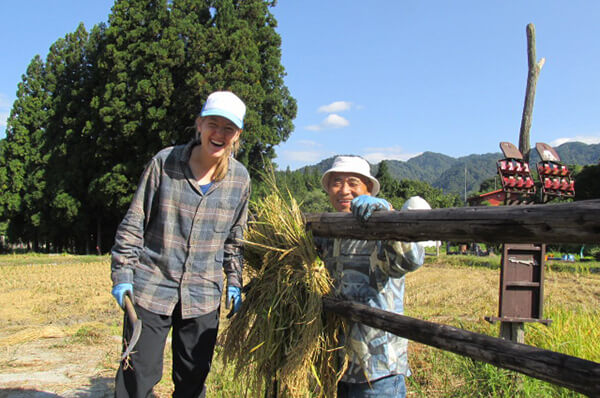
|
|
Brooke and Kentaro harvesting rice by hand with a scythe.
|
I cut quickly and efficiently after this, to the shock of the others who didn’t see the demonstration I received. When you’ve cut enough to fill both hands, you wrap it with a dried stem, tie it off, and then hang it to dry over the fence. Harvesting the entire field takes us several days in the September heat when a machine might have finished the job in an afternoon. But that’s not the point, Kentaro explains to me. Japanese families have harvested rice this way for generations; if it was good enough for them, why shouldn’t it be good enough for us? Squatting for hours over several days strengthens my legs, while the calm, meditative cutting routine strengthens my spirit. I love Kentaro and his family and my experiences with them. Yet, I have always cited this peaceful harvest as my favorite experience in Japan.
The big art show I heard about when I arrived was just around the corner. Many artists stop by the days before the show to set up sculptures in the field alongside Kentaro’s. Everyone in the village has been curious to meet me. I befriended Kentaro’s 87-year-old neighbor and a 12-year-old boy, one of the village's only two children. Kentaro jokingly explains to me, “My wife and I, we are young here. My mother is the average age. You are baby.” But it seems true; I am the only one between 13 and 45 in town. At the end of a workday, Kentaro often drives me to neighboring villages or shows me projects he’s worked on around the community. One day, he drove me to the local elementary school that was shut down five years ago and transformed into a retirement community center. He foresees that this is where his village is going, that soon there will be no one left.
I began understanding why Kentaro has organized his annual art show for the past twelve years. Every October, people from around the area and even distant cities drive to tiny Toyomi to see live music performances in Kentaro’s rice fields. It is not for him; it’s for the community to show everyone how beautiful this tiny village is and how spirited its residents are.
When the day of the big art show finally arrived, Kentaro’s friends from all over Japan came to Toyomi to help out. I put on my best simple cotton day dress, which is far more flattering than my usual sweatpants and T-shirt fashion. The restaurant, which is usually quite empty, is now overflowing with guests. As I serve soba noodles and tempura to these friends, I receive many compliments and eager handshakes. “Brooke! I know you. I read Kentaro’s blog,” many people explain to me. I desperately want to know what Kentaro’s blog says about me and if it is true that these people know me from his descriptions.
Walking out to the rice fields with new friends and learning about everyone is an absolute joy. I see pictures of everyone’s nieces and granddaughters my age, have my future told by a Japanese fortune-teller, and receive more gifts than I can carry. The festival is incredible, with plenty of traditional Japanese music and dance acts mixed in, contemporary dancers twirling around the sculptures, acoustic and folk singers, and even a solo screamo performance. I watch with Obaachan while more and more people come up to introduce themselves and tell me their stories in whatever English they can speak. I am struck by the earnest kindness of all these strangers and their willingness to struggle for words in a difficult language when I am in their country, afraid to speak Japanese.
The final act (an interpretive dance to a traditional folk song in which most dancers are Japanese men in drag) wraps up by dinnertime. We applauded, and everyone congratulated each other, agreeing that the art show was a big success. The mayor of the region came out for the festival, and even the governor of the Niigata prefecture stopped by, which is the equivalent of a state governor coming to an event in the United States. It isn’t until dinner that it sinks in how big this all is that perhaps the fate of these disappearing villages is not set in stone; it’s something we have control over as a society. The loss of places like Toyomi would be a devastating loss for humanity, a loss of diversity in an increasingly globalized world. I had to fly across an ocean to figure this out. Yet, now I’m inextricably implicated in this rural revitalization effort by simply showing that there is outside interest in this lifestyle, this community, this tiny village.
On this celebratory night, Kentaro drinks for the first time since I’ve been here. Everybody drinks. The restaurant is bustling with the joy of old and new friends coming together to show how much they care. My thoughts drift to my family, the Thanksgivings and Christmases I’ve missed, and the countless times I’ve forgotten my parents' and my brother’s birthdays. Pangs of guilt and remorse drip onto my good mood like red wine on a white cloth. I try to focus on the present without allowing myself to forget these essential feelings.
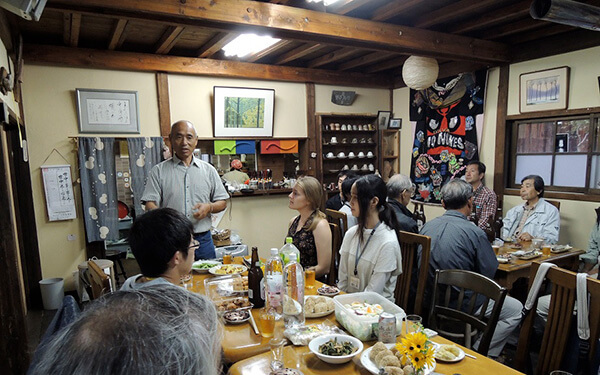
|
|
Evening dinner is before the art show.
|
I always sit next to Kentaro at the table. When the evening chatter begins to bore him, he’ll often turn to me and talk about international exchange, tell me stories from his life, or explain what everyone is talking about in Japanese. This time, however, he leans over and speaks the best English I’ve heard since coming here (alcohol will do that; it helps my Japanese, too).
“There is a Japanese folk tale,” he begins, “the tale of Kaguyahime, do you know it?” I shake my head, no, so he elaborates. The story is about an older couple who always wanted children but had none. One day, the older man cuts bamboo and finds a single stalk glowing with light. He cuts it open and discovers a baby inside. He brings her home to his wife, and they raise this child from bamboo together. She grows up to be very beautiful, but she is somehow not their child even though they raised her. She looks up to the night sky with tears whenever there is a full moon. I am reminded of my first night in Toyomi, spinning underneath the cloudless starry sky with tears in my eyes. “And then,” Kentaro says, “She leaves. She goes to the moon.”
He loses me here. “What?” I ask in confusion. “She is from the moon,” he explains, “It is her home. She goes back to her real family.” An immense sadness strikes me upon hearing this — her real family. “You, you are the girl who goes to the moon,” Kentaro explains, although I had already realized this before he said it. I fight back tears among these friends, this happy time, knowing that he is right.
But he doesn’t have to be right. Maybe Toyomi is my moon. And I’m not Kaguyahime, I’m Brooke. I’m writing my own story, not living out a folk tale. Maybe I belong wherever I can make a difference, and it wasn’t until visiting the moon that I learned I could take the moon’s spirit with me wherever I go. Kindness, generosity, patience, and dedication to a life that means something to me — that is the essence of the moon. I can’t help but wonder if there are incredible rural villages like Toyomi in America that I’ve disregarded and people like Kentaro fighting to make them seen and known. I think of my own family back home and how, in many ways, I’ve been a better daughter to Kentaro in these four weeks than I have to my own family for 22 years.

|
|
The sunset in Toyomi.
|
The moon may seem distant and foreign, but it is theorized to be a chunk of our Earth, broken off and left to circle us from a safe distance. I hope to teach others what the moon has taught me, although the best way to learn from the good people of the moon is to take a chance and go find them yourself.
Brooke Griffin is a recent Harvard University graduate. She is an animator on a yearlong fellowship in Japan, exploring the dynamic relationship between the visual arts and rural lifestyles.
|
